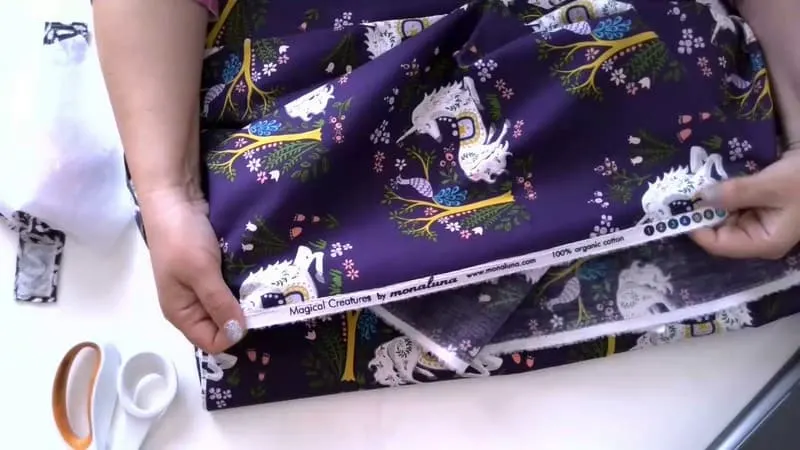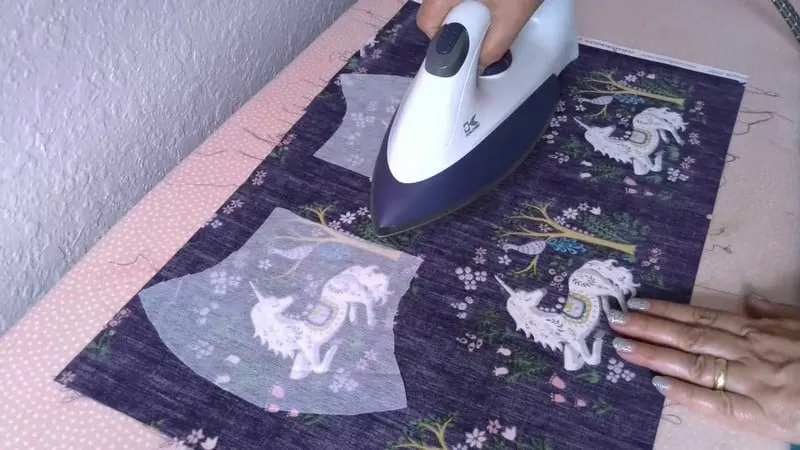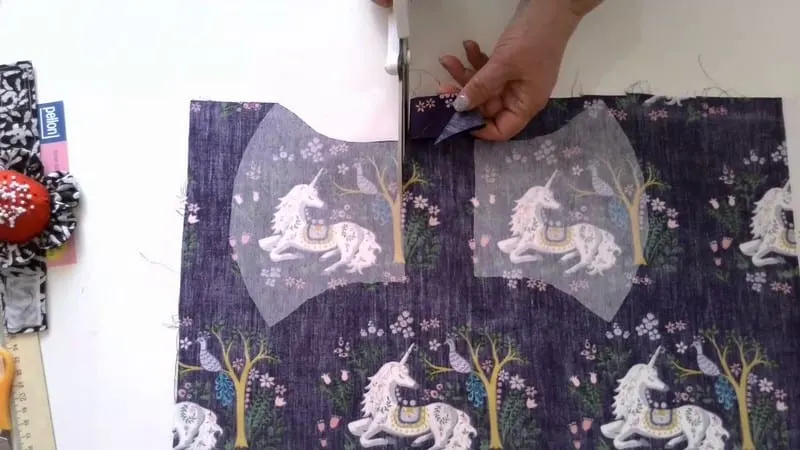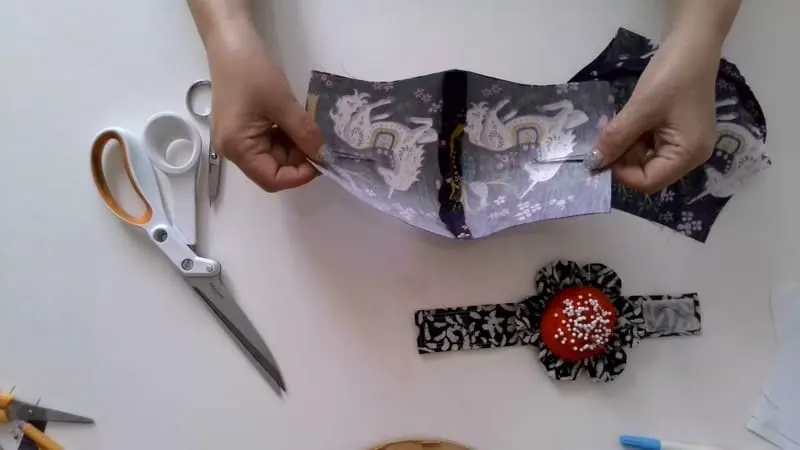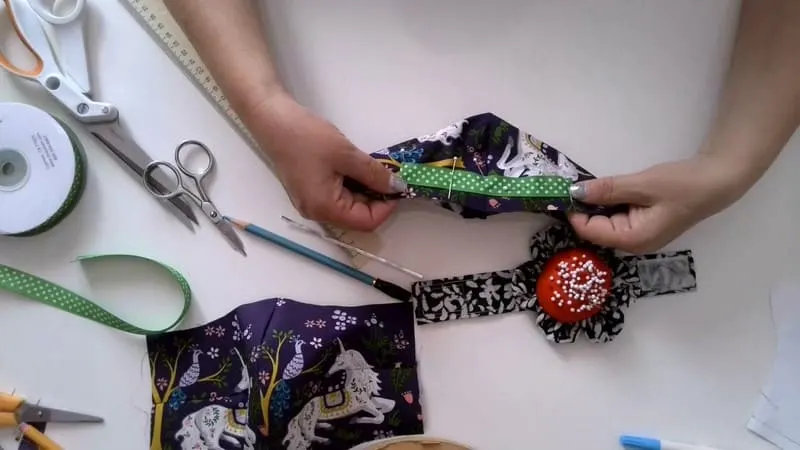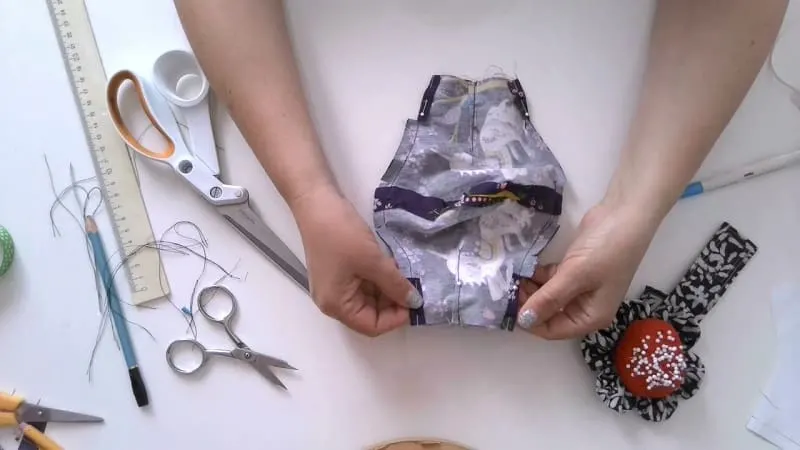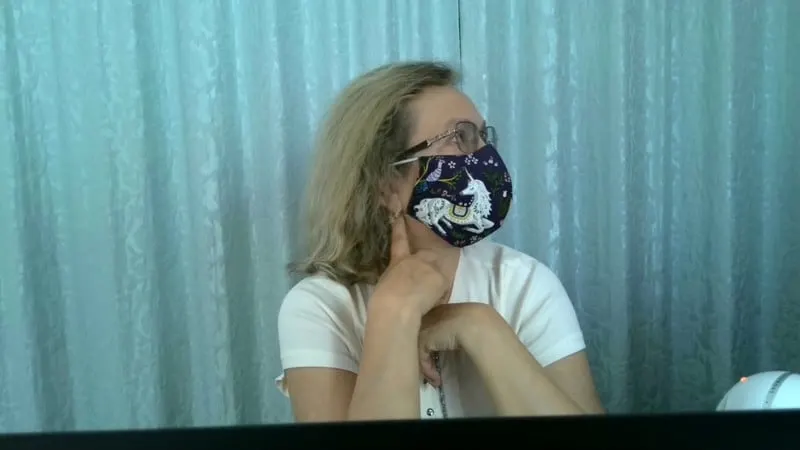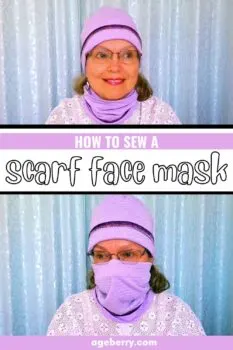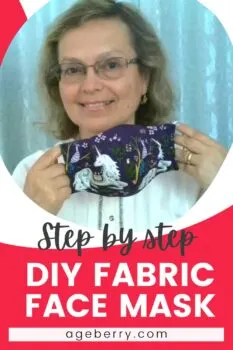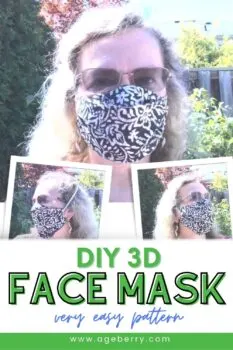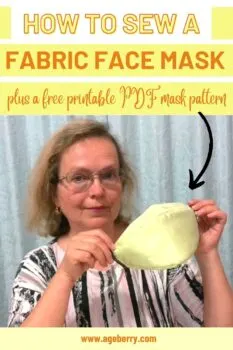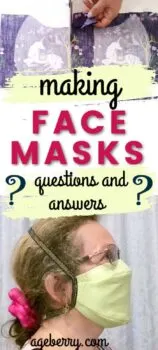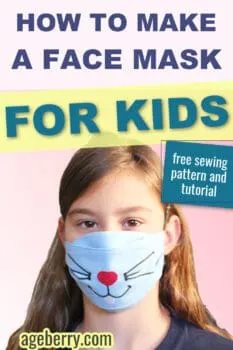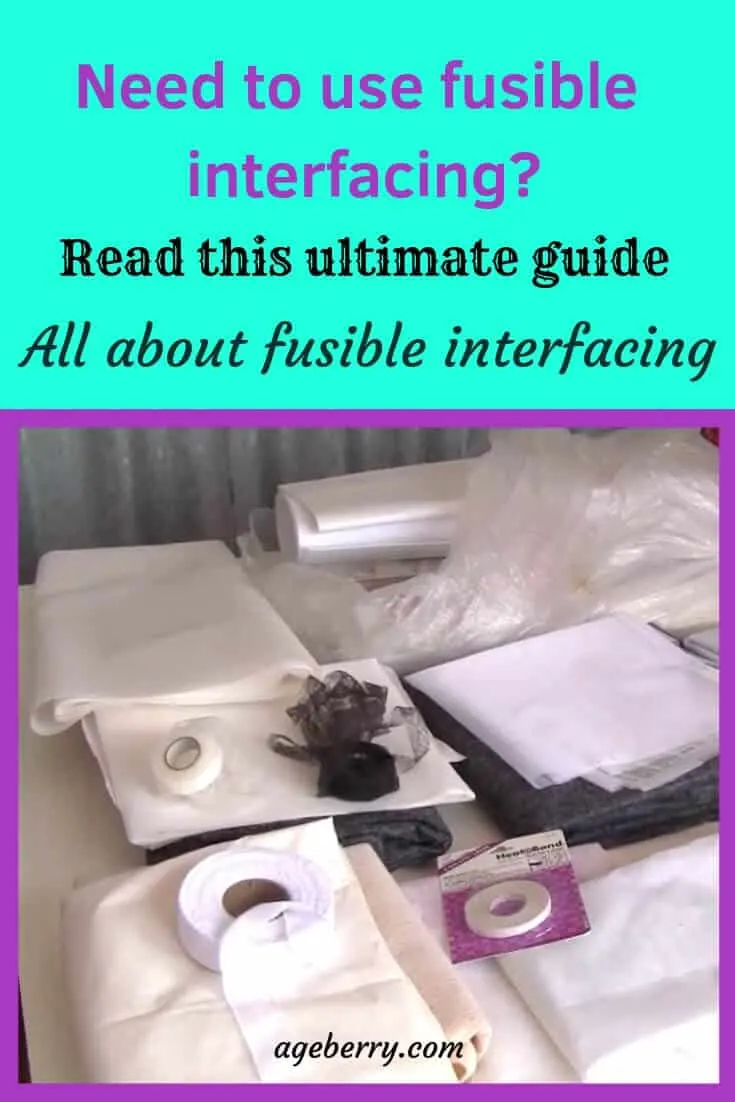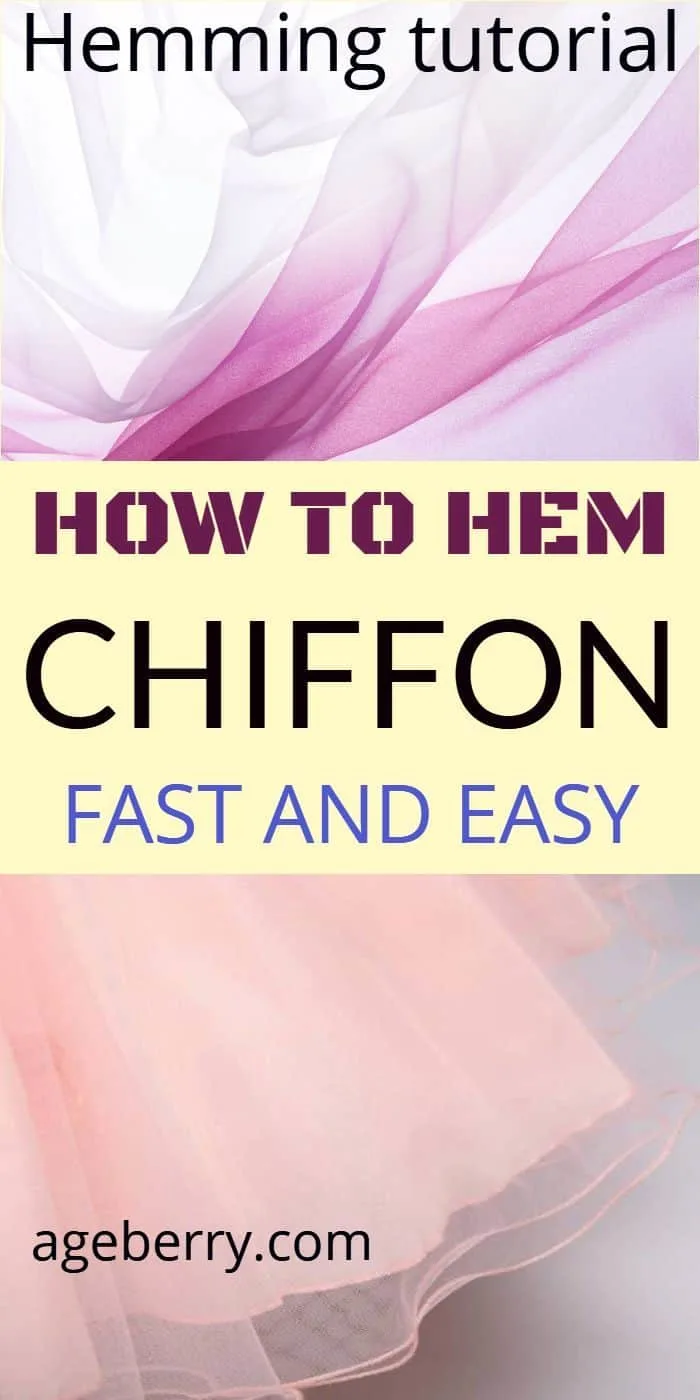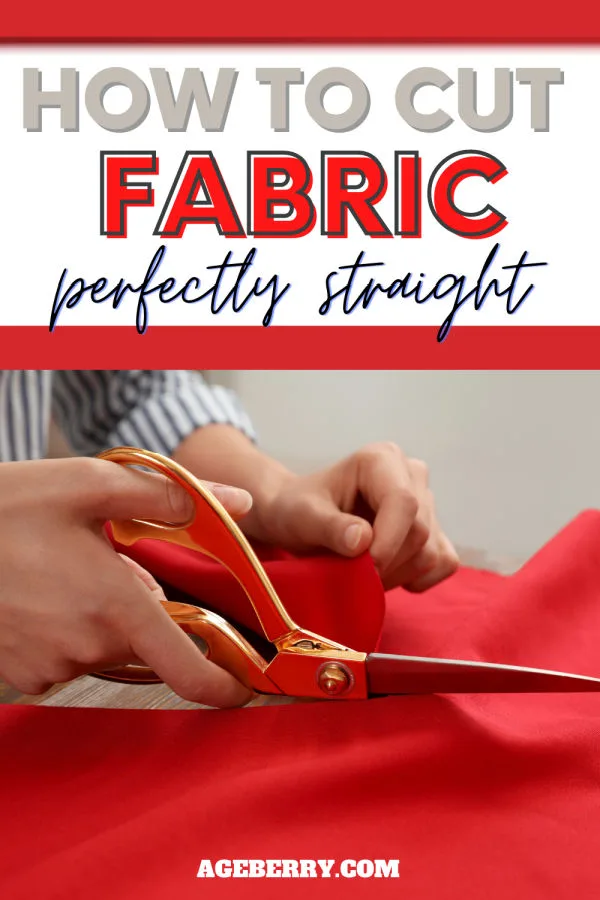In this sewing tutorial, I want to show you how to sew a 3 layer face mask from fabric. I usually wear this mask in my organic garden when I need to spray some plants against bugs. But with this new virus I thought I will share with my readers how to make a face mask from fabric. The mask is made from 100% organic cotton outside and inside, it has a nose insert, elastic loops for ears and it covers nose, mouth and chin.
You can find the link to download the PDF free fabric mask pattern below (the pattern is offered free to all subscribers to my newsletter). However, please read the full tutorial and important instructions before proceeding.
A printable version of this article which includes the pattern is available in my Etsy shop and also in my site shop. Remember, as a subscriber to my newsletter, you can download the pattern for free.
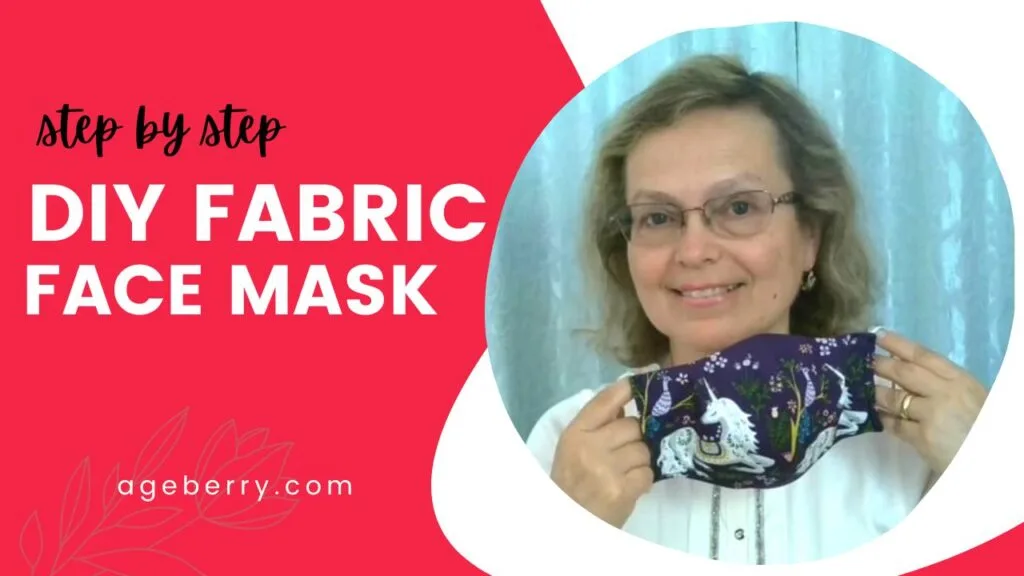
By now masks are sold everywhere in both the USA and Canada. I found a US manufacturer (Patriot Medical Devices) who sells a 3-ply face mask, made in the USA from – they say, I did not test – superior quality materials for about 60 cents apiece. They also share on their site some insight on why to wear a mask (How do face masks work and Disposable Face Masks vs. Cloth Face Masks).
Why would you need to MAKE one, which would obviously require more work than the 60 cents? For a number of reasons.
- Not all masks sold over the counter fit well. This custom-made mask (and the others I created) are fitted.
- Not all masks have an inner layer of non-woven fabric as a filter. This one does.
- Not all masks are looking good; I would rather venture to say that most are quite ugly. This mask you can make from the fabric of your choice, and using techniques described in my DIY kids mask article, you can embellish it as you wish.
And the final question, since as I write this (December 2023) the COVID scare is over. Why would anyone even need a mask in this day and age? The answer to this is simple: I built this mask to use in my garden to begin with! When I was spreading fertilizer or other things than need spraying (for example, a soap solution against aphids and other pests) I needed a mask that would allow mew to breathe while effectively guarding against the spray. This mask works very well for this purpose too.
Note: Some of the links on this page are affiliate links. This means I will receive a commission if you order a product through one of my links. I only recommend products I believe in and use myself.
Have in mind, this mask is not a surgical mask, nor a medical mask but still it might help to prevent infection by viruses and bacteria, which are transmitted from a sick person to a healthy person by airborne droplets. And DIY fabric masks may be the only option available during an epidemic. However not being designed for medical purposes, its usefulness might be limited and is not proven; you should not rely only on wearing such a mask, or any mask for that matter, to protect yourself and the ones around you, it is important to follow all recommended steps (see below).
By now overwhelming evidence shows us that masks are one of (if not THE) most effective protection measure against spreading the Covid-19 virus. And others, too. The US Centre for Disease Control says: “CDC recommends all people 2 years of age and older wear a mask in public settings and when around people who don’t live in your household, especially when other social distancing measures are difficult to maintain.” (read the full article here COVID-19: Considerations for Wearing Masks).
The Canadian federal health officials also have issued similar guidelines, moreover, in the latest developments a 3 layer mask is recommended (two dense cloth layers and one non-woven filter layer): Non-medical masks and face coverings (this is an official Government of Canada site).
And I am sure if we look further, we will find similar guidance or mandatory rules all over the world. After all, surgeons and nurses have been using a mask for as long as I can remember, does anyone think they do it for fun? No. They do it for two reasons:
- To avoid spreading their own germs around
- To protect themselves from accidental spills and fluids that are around an operating theatre.
You should know you can get only a limited protection from these fabric masks, and the masks are better at protecting OTHERS (by limiting the particle emission from your mouth and nose), so it is very important that everyone wear a mask in a public setting.
Even outside, when you meet someone on a trail, in the park. Did you ever feel the faint smell of a perfume, for example? I bet you did; I know I did. Well, guess what. The perfume particles have traveled from the person you met to you, and probably in a similar manner the air the person breathes can do so. That is why is important that in addition to masks we keep our distance. Not pleasant, but necessary.
Remember that the use of a face mask is not the only method of prevention, and numerous studies have confirmed that the most effective protection against diseases transmitted by airborne droplets is possible only if all necessary measures are observed.
The following are the directions given by the CDC for prevention; here is a link to the CDC site. The summary is below:
- Wash your hands often with soap and water for at least 20 seconds. If soap and water are not available, use an alcohol-based hand sanitizer.
- Avoid touching your eyes, nose, and mouth with unwashed hands.
- Avoid close contact with people who are sick.
- Stay home when you are sick; keep your children at home if they are sick.
- Cover your cough or sneeze with a tissue, and then throw the tissue in the trash.
- Clean and disinfect frequently touched objects and surfaces.
In a recent post (Strategies for Optimizing the Supply of Facemasks) CDC has acknowledged the possible usefulness of home made masks when nothing nothing certified to use for medical purposes is available but has also warned that home made masks or other non-certified methods of protection are not tested nor guaranteed.
Along with these methods, the use of a face mask for several hours, especially if you need to visit crowded places, helps to reduce the risk of infection to some degree.
You can also use a fabric face mask in paintwork and other repair work, landscape, gardening, spraying, working with chemicals at home, etc.
How to use a fabric face mask
Like any personal protective equipment and device, a face mask must be applied according to certain rules. Compliance with them will help to increase efficiency.
A protective mask should be worn for a maximum of 2 hours, after which it is saturated with moist exhaled air and filters microorganisms worse, and also creates a favorable environment for the multiplication of bacteria and viruses.
Some people have noted that bacteria and viruses are unlikely to reproduce on fabric. On clean fabric it is very likely neither viruses nor bacteria would reproduce WELL; I would not bet they would not reproduce at all, unless the fabric was sterilized. But a mask is not clean. It has skin cells just rubbed from your face, fat cells coming from your skin or nose, stuff from your own nose, spit (you speak, right?) and other organic matter which may very well contain living cells (perhaps you bit your tongue? blood cells there); you have it in you, it will get on the mask. Not counting pollen and other pollutants that are coming from the outside. Common sense tells me that you add water and body temperature and this is a good medium for microorganisms, given time. My unprofessional opinion.
However, if the mask becomes wet from coughing, sneezing, or breathing, it should be replaced immediately.
After use, it should be removed and washed with soap or detergent and then ironed with a hot iron, or soaked in a special antiseptic solution. After changing the mask, hands should be thoroughly washed with soap or treated with an alcohol-based antiseptic gel.
It’s recommended to wear face masks indoors, in places with a large crowd of people, or when you are in a room with a sick person. CDC guidance for wearing a mask can be found at this link.
Also, you can’t eat, drink or smoke moving the mask to the side: this will reduce all attempts to defend yourself to nothing and since you will use your hands to handle the mask, the simple act of moving it will negate its purpose.
What rules to apply when making a fabric face mask at home
But fabric masks (if done properly) have also some additional benefits. As a rule, medical three-layer disposable masks are sold in the same size, which may not always be good, given that the size of the head is different for everyone, and the mask should fit snugly to the face to increase its effectiveness. But if you sew the fabric mask yourself you can always make it the size you need.
The effectiveness of the mask is higher, the denser it fits on the face. If the mask doesn’t fit tightly to the face contaminated air gets inside when inhaling, bypassing the filter material.
So the main requirement to the fabric mask is to fit as close as possible to the face. If you make the mask and see that there is a large free volume of air between the inner surface of the mask and the face which quickly becomes warm and moist you should remake it because this is an ideal environment for the reproduction of bacteria and viruses. From a remedy, it will turn into a potential health hazard.
It should also be hypoallergenic if you suffer from allergic reactions to various chemicals and materials.
The mask must satisfy reliable filtration of the inhaled and exhaled air. It should not allow microorganisms (viruses, bacteria, fungi) to pass through and at the same time not impede breathing, because sometimes you have to wear a mask for a long time.
For kids, you can make a fun mask from cotton fabric with animal prints or cartoon characters and turn the process of putting it on into a fun game which is often the key to success.
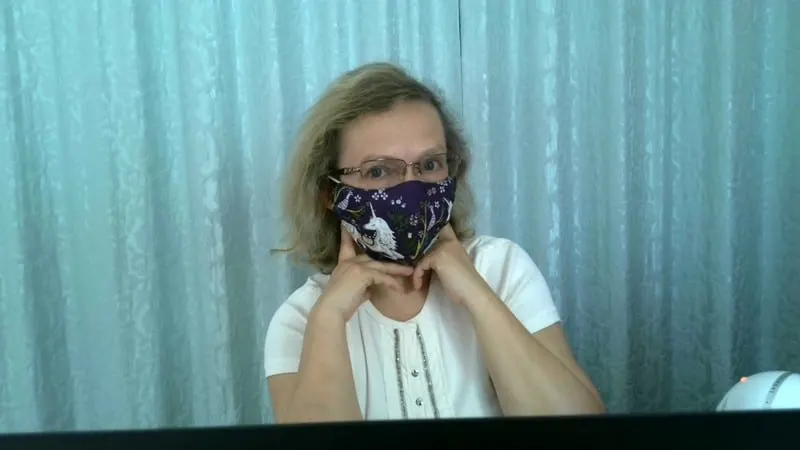
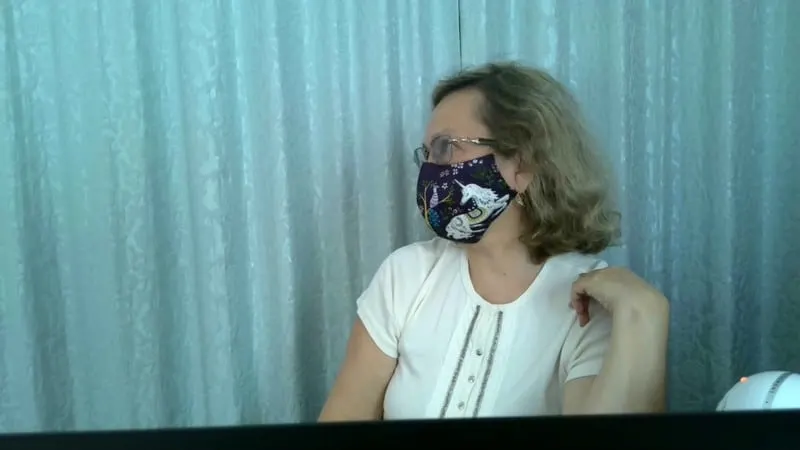
If you prefer to watch the tutorial go to my YouTube channel to see the video.
What you’ll need
Organic 100% cotton woven fabric. Read more about choosing the fabric below.
Sewing machine
Interfacing (non-woven, fusible, or non-fusible)
A piece of ribbon
Regular sewing supplies
Step-by-step instruction – how to sew a face mask
I started to sew my mask by making a pattern. I wanted to make a mask that protects the mouth, and nose and closes the chin also.
You can find a PDF of the mask in 2 sizes – adult and child in my RESOURCE LIBRARY.
The pattern includes 2 pieces – one for the mask’s front and second for the lining of the mask (which is 1/8″ or 3-4 mm smaller than the main piece). Seam allowances are included and they are ⅜” (or 1 cm). Print 2 copies and cut one for the main part (THE FRONT PIECEs) and one for the lining piece (inside parts).
I made the pattern for my face (by trial and error) so if you want to make a mask for your face, you might need to adjust the pattern for a proper fit.
Adjusting the pattern is EASY! Just cut 2 pattern pieces, baste them together and TRY IT ON. You MUST see how it fits before continuing (see steps below).
Proper mask shape and ability to mold to the face boost its effectiveness. You need to sew a snug-fitting mask for better performance.
Make necessary changes to the pattern if you adjusted it for your face.
But have in mind the lining pieces should be about ⅛” (3-4 mm) smaller than the main piece for proper fit.
Note: this is not a pattern, the image scale might be wrong; the pattern can be downloaded from my “resource library” page.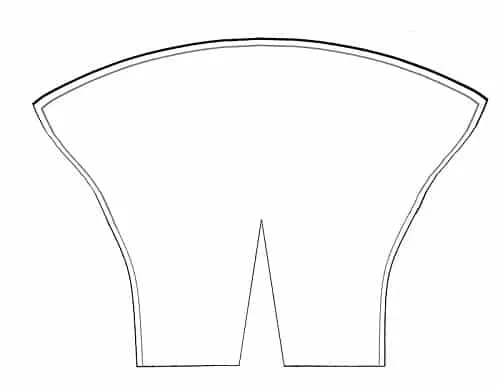
I got lots of positive comments on this post and I am glad that this tutorial is helpful. I decided to publish another tutorial on how to make a cloth face mask, this one has no darts and the face is flat. I also have a third version, somewhat easier to sew here: How to sew a face mask using my free printable face mask template. All patterns are free in my RESOURCE LIBRARY for all subscribers to my newsletter. Check them all and decide which one you like better.
I have another useful sewing project – how to sew a bucket hat with a face shield. Check it out and make one today!
Step 1
They say that face masks have NON-WOVEN layers and masks with interfacing are better, so I decided to use Pellon non woven fusible interfacing for my fabric mask. At the time I made the masks I did not know of any study that shows it to be unacceptable for such use (and I still don’t), I was concerned only that it may cause allergies. However later a number of readers have drawn my attention to the fact that the glue in the fusible interfacing may introduce chemicals that a non-fusible interfacing does not, therefore it might be better to use non-fusible interfacing for the third filtering layer. A non-fusible interfacing will probably be as effective as the one I used but without the glue an extra chemical would be eliminated so yes, it makes sense.
I used this one – Ultra lightweight fusible interfacing by Pellon for my face mask.
If you are not sure how to use fusible interfacing properly check out my tutorial How to fuse interfacing – tips, and tricks.
Cut two pattern pieces from this interfacing.
BUT IF YOU ARE MAKING THE MASK FOR A PERSON WITH ALLERGIES OR FOR A CHILD – DON’T USE FUSIBLE INTERFACING. USE JUST A REGULAR NON FUSIBLE NON-WOVEN INTERFACING. Who knows if it’s good to breathe through the glue on the interfacing. The amount is very small of course and I never had any problems with it so I made my mask with fusible interfacing. But if you have any doubts USE NON FUSIBLE.
On the other hand, non woven material they use in medical masks is another chemical (it’s not natural, it’s polymer material) so I guess you can’t win everything, there is always a compromise.
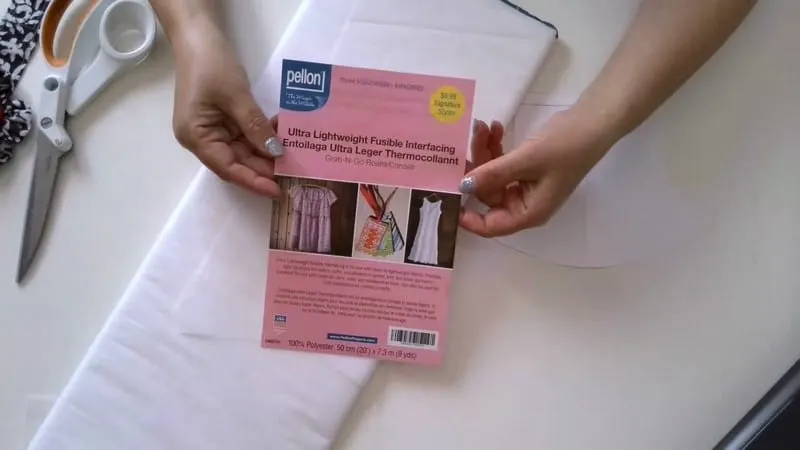
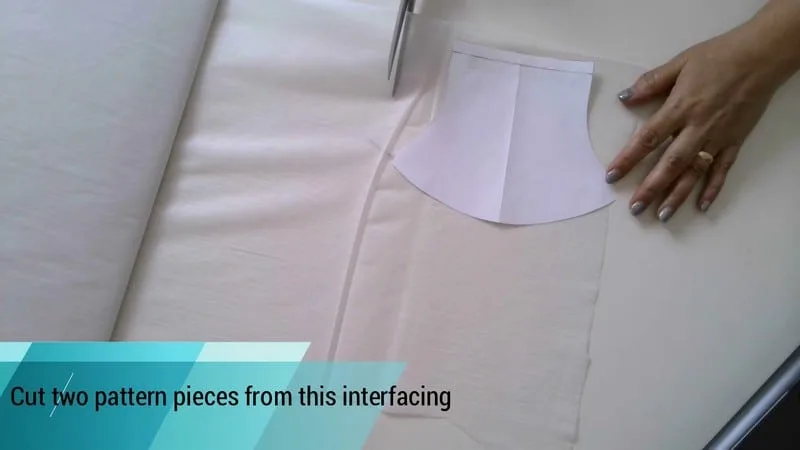
Step 2
Now let me tell you about the fabric. I used ORGANIC 100% COTTON fabric. I think it’s better for the face. Now we can buy organic cotton very easily. Read my article on the benefits of organic fabric at this link.
My cotton fabric is medium weight and dense (without any holes) which is great for the mask.
Prewash the fabric in hot water (if you don’t want the mask to shrink after the first wash) and iron it to smooth all wrinkles.
Step 3
Attach the fusible interfacing with a hot iron (without steam). If you want to know how to use fusible interfacing correctly I have a tutorial at this link.
I have an unusual pattern on my fabric so I had to be creative with placing my pattern pieces. I don’t want to cut these cute Unicorns.
But don’t cut the pieces on the bias. Try to place them with the straight edges parallel (or perpendicular) to the grainline of the fabric.
Step 4
Cut 2 front pieces of the mask with good fabric scissors.
Cut also 2 pieces of lining. (Remember, lining pieces should be a bit smaller than the main pieces).
You have to cut out 2 mirrored pieces, left and right. Their shape is exactly the same but they are not identical. They are cut in opposite directions because they are symmetrical mirror images of each other.
Step 5
Now we are going to sew darts.
Cut the darts on the paper pattern pieces. Don’t cut them on fabric pieces of course.
Draw darts on fabric pieces using a fabric marker. We have 2 front pieces of the mask and 2 lining pieces. All of them have darts.
Fold each piece in half and pin preparing the darts for stitching.
Sew all the darts. Start sewing a dart from the edge of the pattern to the center. Backstitch in the beginning but don’t backstitch in the end. Tie the threads at the end of the dart and cut them. Cut also the other thread tails.
Press all the darts, making sure they are pressed in different directions on the main pieces and on the lining pieces.

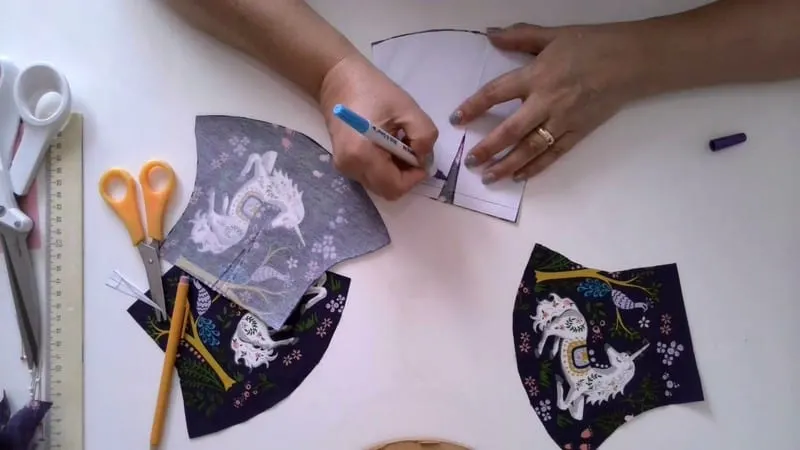
Step 6
Baste 2 main pieces of the mask right sides together (by hand sewing), seam allowances are ⅜” (or 1 cm), and check how it fits around the nose. It’s very easy to do. After that make necessary adjustments to the pattern. The mask shouldn’t be loose around the nose.
I noticed that for the correct fit the side seams should be a bit smaller than your ears. If the sides (in the finished mask) are bigger than the ears the mask will not sit close to your face at the sides.
If you need to make the mask smaller for a child remember that the pattern has ⅜” seam allowances up and down and at the sides, so cut accordingly.
After you are done with fitting pin 2 front pieces and 2 lining pieces right sides together as you see in the image below.
Stitch the middle seams and press seam allowances open on the front piece and on the lining.
It may be difficult to press the seams which are curved. I use a tailor’s ham for this – check out how you can make one yourself.
Step 7
I see that the surgical masks have a thin metal insert for better fitting around the nose which increases its effectiveness in protecting against the penetration of microorganisms. So I took one from a store-bought mask. You can do the same. It provides a snug fit to the nose and you can change the area of contact depending on the size of the nose. In fact, any piece of wire, not very soft, not very stiff, will do. Some readers suggested pipe cleaners (two twisted together and trimmed), stems from artificial flowers, or even garbage bag ties.
Make a small casing for the metal nose insert. I used a piece of ribbon for this.
Nancy sent me via email the following and I think it is useful: “Another option for the metal nose piece. A piece of 26 gauge cut to 12 inches long. Fold into thirds, making sure the ends are within the folded portion. Twist. The loops can easily be flattened to fit a small casing. A small finger stitch will keep it in place if you don’t close the ends of your metal casing”.
Pin it to the lining piece at the distance a little bit more than ⅜” (1cm) from the fabric edge and stitch. Make two seams to form a casing for inserting the metal piece.
You have to attach the ribbon to the right side of the lining piece which will cover your nose.
If you have problems understanding this step you can see it in detail in my video tutorial on Youtube.
Step 8
Pin the front piece and the lining right sides together. Make sure the ribbon insert for the nose is placed up if you have a special pattern on your fabric. For example, I didn’t want my Unicorns upside down on my mask.
Make only 2 seams: one up and one down the mask. LEAVE ABOUT 1 INCH (or 2 – 2.5 CM) WITHOUT STITCHES ON ALL SIDES. You will see later why.
ALSO, LEAVE OPEN around 2 INCHES (or 5 CM) IN THE BOTTOM SEAM FOR TURNING THE MASK RIGHT SIDE OUT.
If you have problems understanding this step you can see it in detail in my video tutorial on Youtube.
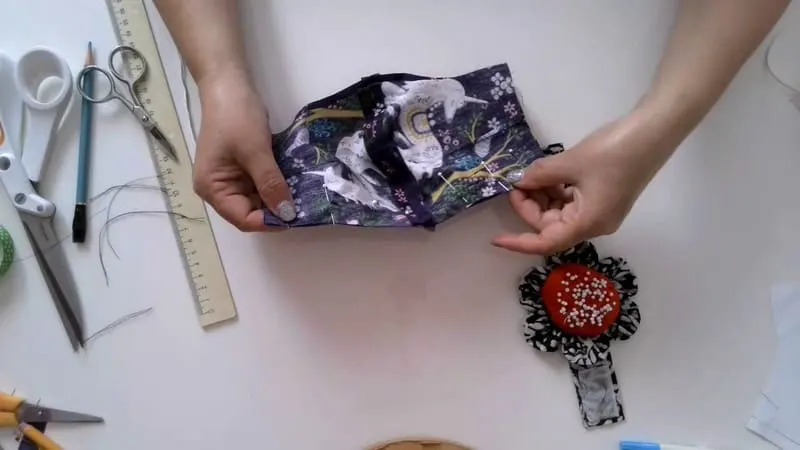
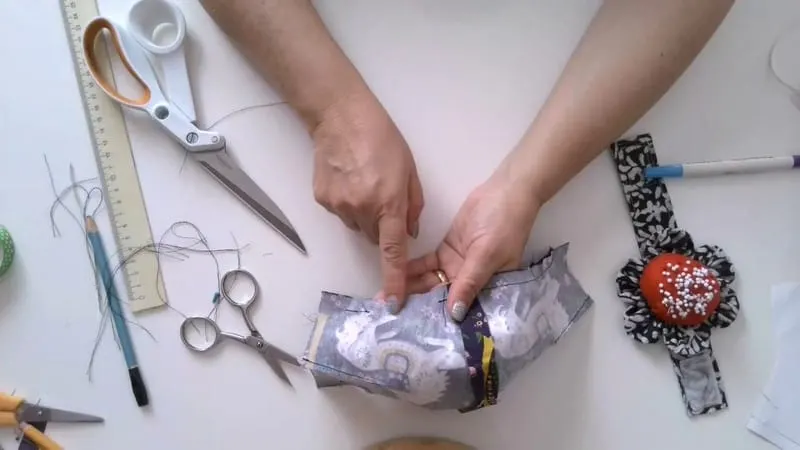
Step 9
Ok, I made 2 seams up and down and I have 1 inch not stitched on all sides and I also have the opening for turning the mask right side out.
These seams are not straight, they are curved so I have to make small cuts close to the seams so when I turn the mask right side out there will be no pulling in the seams.
Now we need to stitch the sides. But I want to make casings for elastic loops on both sides.
So for this fold the seam allowances as in the image below and make the side seams.
If you have problems understanding this step you can see it in detail in my video tutorial on Youtube.
Step 10
Cut the seam allowances at the side seams close to stitches.
Turn the mask right side out. Smooth every corner. Baste the mask around all edges and press with an iron.
Topstitch the bottom edge only (you will need to close the opening). I didn’t want to topstitch the upper edge because there is the ribbon insert.
Remove the basting thread.
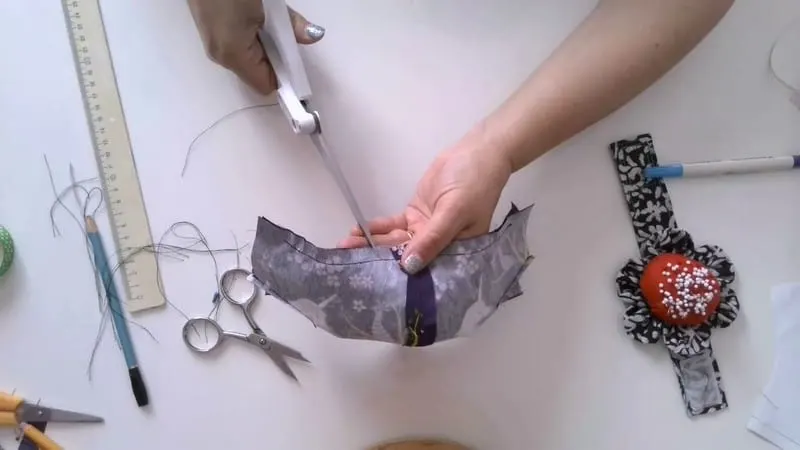
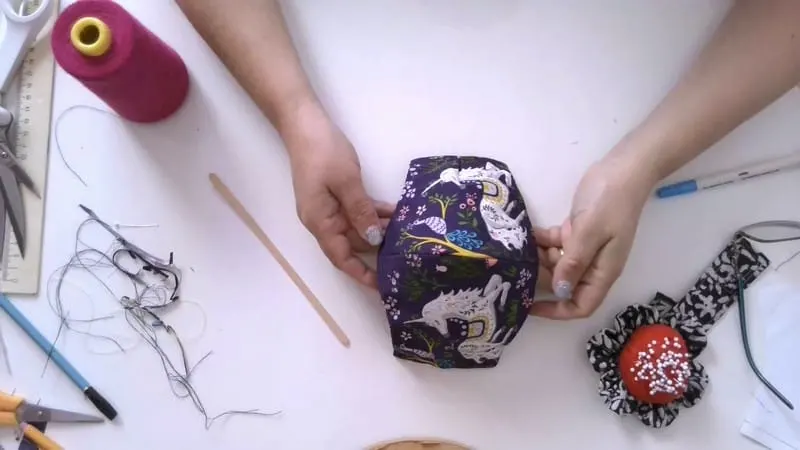
Step 11
So, we made casings for the elastic loops.
Now we need to insert elastic for the mask. Elastic loops make the process of putting the mask on as simple as possible.
Elastic has to be very thin and soft so it doesn’t make any discomfort to the ears.
I have this very nice elastic, it’s silver and would look great with this fabric. But I see it’s a little bit too hard so I decided to go with less fancy regular elastic which is softer.
Insert the elastic using a safety pin. Measure the elastic around your ears so the mask sits comfortably – not very tight, so it doesn’t pull your ears, but not very loose also. Make a knot when you are done and pull the knot inside the mask so it’s not visible.
Step 12
The last step is fixing the elastic inside the mask so the sides stay flat around the face. I just made big zigzag stitches at the sides.
After you are done insert the metal piece for the nose.
Now let me show you a few images of me wearing the mask.
I have other popular tutorials about face masks on my site that might be interesting for you. Check them out below. All of them have free patterns (you will need to subscribe to my newsletter for that) and most also have a how-to video. All these masks are 3 or 4 layers and fit well on the face.
Did you find this tutorial helpful? If so, save this pin (see below) on your sewing board so you can come to this tutorial later when you want to sew a face mask from fabric and follow me on Pinterest for more tips, tutorials, and inspiration!
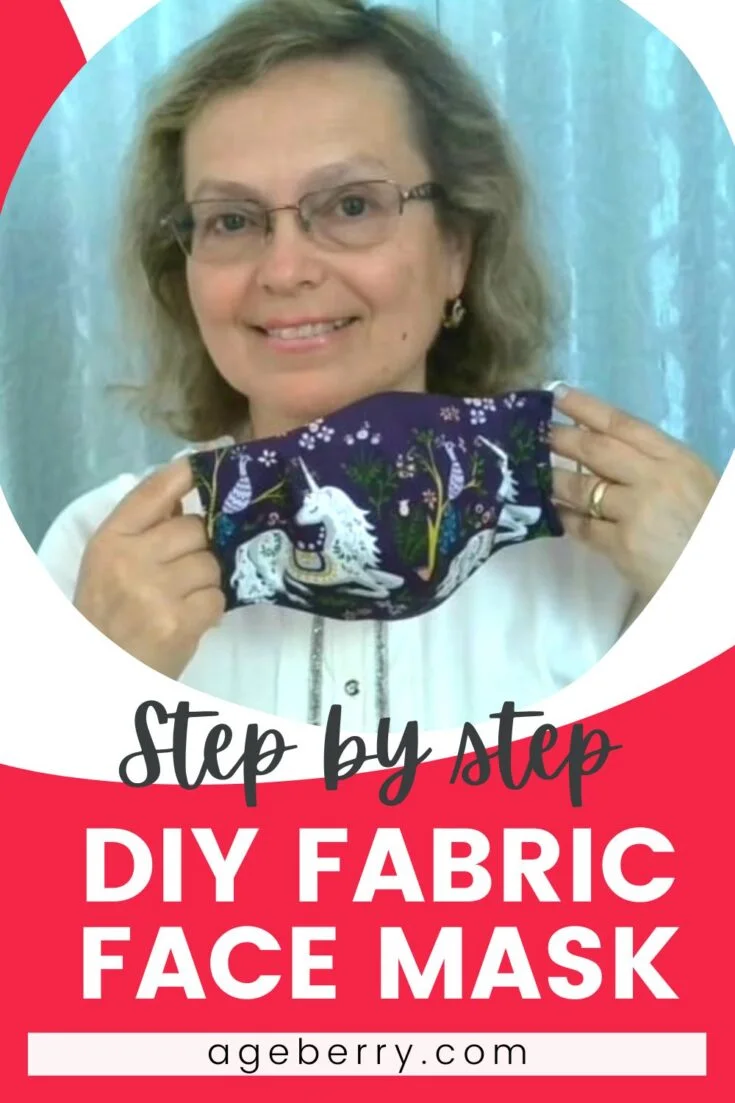
Ready to take the next step in your sewing journey? Check out more step-by-step tutorials from my site and don’t forget to share!
latest posts
- Ditch My Sewing Machine? Not in This Lifetime!
- Adorable DIY Needle Book | Easy Tutorial for Beginners
- Master the Seam Ripper: Your Ultimate Guide to Precision Stitch Removal
- Think You Know Zippers? This Installation Guide Might Surprise You
- Why Does Your Seam Ripper Have a Red Ball? Discover Its Purpose!
- Topstitching Troubles? This Simple Trick Will Turn It Around Instantly!
- How to Sew Shirring: A Step-by-Step Guide to Elastic Thread Gathering
- Are Self-Threading Needles Really Useful?
- Amazon Spring Sale: Best Choices




